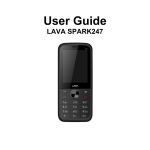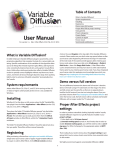Download GV-GIS
Transcript
GV-GIS User’s Manual V2.0 © 2009 GeoVision, Inc. All rights reserved. Under the copyright laws, this manual may not be copied, in whole or in part, without the written consent of GeoVision. Every effort has been made to ensure that the information in this manual is accurate. GeoVision is not responsible for printing or clerical errors. GeoVision, Inc. 9F, No. 246, Sec. 1, Neihu Rd., Neihu District, Taipei, Taiwan Tel: +886-2-8797-8377 Fax: +886-2-8797-8335 http://www.geovision.com.tw Trademarks used in this manual: GeoVision, the GeoVision logo and GV series products are trademarks of GeoVision, Inc. Windows and Windows XP are registered trademarks of Microsoft Corporation. November 2009 Contents Chapter 1 1.1 Introduction............................................................................ 1 Features ...................................................................................... 2 1.2 System Requirements................................................................. 3 1.3 Overview of GV-GIS.................................................................... 5 Chapter 2 1.3.1 Main Screen ................................................................... 5 1.3.2 Toolbar............................................................................ 6 1.3.3 Event List........................................................................ 8 Getting Started....................................................................... 9 2.1 Installing the GV-GIS................................................................... 9 2.2 Creating Host Accounts............................................................. 11 2.3 Chapter 3 2.2.1 Creating a Mobile Host................................................. 11 2.2.2 Creating a Fixed Host .................................................. 12 Connecting Hosts to the GV-GIS .............................................. 14 2.3.1 Connecting a Mobile Host ............................................ 14 2.3.2 Connecting a Fixed Host .............................................. 15 Tracking Operations for Mobile Hosts............................... 16 3.1 Starting the Tracking Services................................................... 16 3.2 Tracking Features ..................................................................... 16 3.3 Viewing Live Video.................................................................... 19 3.4 Playing Back GPS Tracks ......................................................... 21 3.3.1 3.5 3.6 Colorful Mode ............................................................... 20 3.4.1 Setting Playback Default Time Range.......................... 23 3.4.2 Showing the Time when a Host Passed by a Point...... 24 3.4.3 Showing GPS Tracks while retrieving the recordings .. 24 Tracking Multiple Hosts ............................................................. 25 3.5.1 Tracking Locations ....................................................... 25 3.5.2 Tracking Addresses...................................................... 26 Detecting Detours ..................................................................... 27 3.6.1 Defining a Detection Area ............................................ 27 3.6.2 Planning a Detection Route ......................................... 28 i 3.7 Detecting Idle Speed ................................................................. 30 3.8 Detecting Over Speed ............................................................... 32 3.9 Viewing a List of Detection Settings.......................................... 33 3.10 Searching for Places and Devices .......................................... 34 Chapter 4 Monitoring Operations for Fixed Hosts ............................. 38 4.1 Starting the Monitoring Services ............................................... 38 4.2 Monitoring Features .................................................................. 39 4.2.1 Fixed Host Icon ............................................................ 39 4.2.2 Camera Icon................................................................. 40 4.2.3 Output Icon................................................................... 41 4.3 Detecting Motion and Input-Triggered Events........................... 41 4.4 Retrieving Recorded Video ....................................................... 43 Chapter 5 4.4.1 Instant Playback ........................................................... 43 4.4.2 Remote ViewLog .......................................................... 46 Advanced Operations ......................................................... 47 5.1 Creating an E-Map .................................................................... 47 5.2 Adding a Place .......................................................................... 49 5.3 Saving a View ........................................................................... 50 5.4 Getting Driving Directions ......................................................... 51 5.1.1 5.5 Self-Defining Event Colors ........................................................ 52 5.6 Showing Host Position on an Alarm Event................................ 53 5.7 Applying Longitude and Latitude Positions on Fixed Hosts ...... 53 5.8 Monitoring GV-I/O Boxes .......................................................... 55 Chapter 6 Event Log Browser.............................................................. 56 6.1 Opening the Event Log ............................................................. 58 6.2 Filtering the Event Log .............................................................. 59 6.3 Backing up the Event Log ......................................................... 60 6.4 Printing the Event Log............................................................... 62 Chapter 7 7.1 ii Configuring E-Map Icon Settings ................................. 48 System Configurations ....................................................... 63 Layout Settings ......................................................................... 63 7.2 Network Settings ....................................................................... 64 7.3 Event Log Settings .................................................................... 65 7.4 Remote ViewLog Settings......................................................... 66 7.5 Alert Intervals ............................................................................ 67 Chapter 8 Notification Settings............................................................ 68 Chapter 9 Output Alerts ........................................................................ 70 9.1 Adding Output Devices ............................................................. 70 9.1 Forcing Outputs of GV-GIS ....................................................... 71 9.2 Forcing Outputs of a Host ......................................................... 71 Chapter 10 SMS Alerts .......................................................................... 72 10.1 Setting SMS Server................................................................. 72 10.2 Connecting to SMS Server...................................................... 74 10.3 Sending SMS .......................................................................... 74 10.4 Inserting ID and Camera Name to Alert Messages................. 75 Chapter 11 11.1 11.2 E-Mail Alerts ....................................................................... 77 Setting Mailbox........................................................................ 77 11.1.1 Setting up the mailbox ................................................ 77 11.1.2 Sending a Test E-Mail................................................. 78 Sending E-Mail ........................................................................ 78 Chapter 12 Failover Support ................................................................ 79 Appendix…. .............................................................................................. 81 A. Dongle Options ........................................................................... 81 B. Upgrading the Black Dongle ....................................................... 81 C. Shortcut Keys ............................................................................. 83 D. Specifications.............................................................................. 84 iii 1 Chapter 1 Introduction Introduction The GV-GIS is a GIS (Geographic Information System) based central management system for GeoVision devices. The vehicle tracking and location verification remotely from the GV-GIS is made possible by the GPS receiver installed in GV-Video Server and GV-Compact DVR to constantly obtain the GPS data (vehicle coordinates and speed) from the satellite, and through mobile internet connection (e.g. UMTS, EDGE, GPRS, GSM, etc) to transmit the GPS data to the GV-GIS. Besides real-time vehicle tracking, you can also monitor the location of cameras and the status of I/O devices from the DVR devices, without GPS functions. Satellite Get GPS data from Satellite GV-Video Server + GPS Reciever GV-Compact DVR + GPS Reciever Mobile Hosts Mobile Internet Connection, e.g. UMTS, EDGE, GPRS, GSM, etc. GIS E-Map Geo-GIS Central Management System (GIS+ E-Map + Live Image) TCP/IP Fixed Hosts GV-I/O Box GV-IP Camera GV-Compact DVR GV-Video Server GV-System GV-NVR Figure 1-1 1 1.1 • • • • • • • • • • • • • Features GIS central management system 500 vehicles tracking at one time Real-time vehicle GPS coordinates Real-time vehicle video image Google Maps, Microsoft Virtual Earth and user-defined maps support GPS Tracks playback Detour Detection Idle Speed Detection Over Speed Detection E-Map Support Motion and Input-triggered alert for fixed hosts Customized landmark (interested points) setting Integration with GV-I/O Box, GV-Video Server, GV-Compact DVR, GV-IP Camera, GV-System and GV-NVR 2 1 1.2 1. Introduction System Requirements The minimum system requirements to run the GV-GIS: Standard Version 10 Mobile-Host Map Views 10 Mobile-Host Map Views with up to 10 Megapixel Live Views OS Windows 2000 / XP /Server 2003 / Vista CPU Pentium 4 3.0 GHz with HT Core 2 Quad, 2.4 GHz Memory 2 x 512 MB Dual Channels 2 x 1 GB Dual Channels Hard Disk The hard disk space required to install GV-VIS (Standard Version) must be at least 1 GB. VGA NVIDIA GeForce 8600 GT / ATI Radeon X1650 DirectX 9.0c Browser Microsoft Internet Explorer 7.x Advanced Version (Up to 500 Mobile Hosts) 16 Mobile-Host Map Views 16 Mobile-Host Map Views with up to 16 Megapixel Live Views OS Windows 2000 / XP / Server 2003 / Vista CPU Pentium 4 3.0 GHz with HT Memory 2 x 1 GB Dual Channels Hard Disk Core 2 Quad, 2.4 GHz The hard disk space required to install GV-VIS (Advanced Version) must be at least 1 GB. VGA NVIDIA GeForce 8600 GT / ATI Radeon X1650 DirectX 9.0c Browser Microsoft Internet Explorer 7.x Note: Currently the 64-bit Windows operating system is not supported. 3 2. DirectX 9.0C installed. Available from the software DVD. 3. Microsoft Internet Explorer 7.x. 4. A GV-GIS dongle is required for the GV-GIS software to work. y The primary USB dongle provides 10 vehicle connections. The number limit is 500 connections with the increment of 5 connections at a time. Inform your sales representative the required number of vehicle connections so the dongle can be delivered upon your requirements. Otherwise, you can upgrade your primary dongle later by following the instructions in Appendix B. Upgrading the Black Dongle. For example, if you need 33 vehicle connections and already have a primary dongle, you can upgrade the primary dongle from 10 to 35 connections. y It is required to install drivers from the software DVD for the USB dongle to work. Note: 1. 2. For types of GV-GIS dongles, see Appendix A. Dongle Options. For the Defog and Stabilizer functions on Live View, the GV-GIS dongle with AVP function is required. 4 1 1.3 Introduction Overview of GV-GIS Get yourself familiar with the Main Screen, Toolbar and Event List, as it will help you when you read further in the following sections. 1.3.1 Main Screen Microsoft Virtual Earth is used as Map API (Application Program Interface) in this example. Figure 1-2 No. Name 1 Host List Description Include these types of folders: Mobile Host List, Fixed Host List, Expended Markers, and New Map. 5 2 Navigation Controls 3 Views 4 Map 5 Overview Map Use these to zoom, look and move around. Click these to display different views, including aerial images and street level imagery. This area displays the tracking map, E-Map and query results. This view shows the location of current map view. Activate monitoring of events of video motion and 6 Monitor List input trigger occurred at the fixed host. See 4.3 Detecting Motion and Input-triggered Events. Indicate the connected mobile hosts. Take the picture 7 Tracking Host Indicator for example. Three (3) mobile hosts are connecting to the GV-GIS while GV-GIS supports the maximum of 50 mobile hosts. 8 Event List See Event List later. 9 Toolbar See Toolbar later. 1.3.2 Toolbar Figure 1-3 No. Name Description 1 Start/Stop Service Start or stop the GV-GIS services. 2 System Configuration 3 Account 6 Configure the system. See Chapter 7 System Configurations. Configure host accounts. See 2.2 Creating Host Accounts. 1 Introduction Configure which event to send notifications 4 Notification Setting when it happens. See 5.10 Notification Settings. 5 Local I/O Device Control 6 Event List 7 Monitor List Open the list of available I/O devices on your system. Open or close the Event List on the main screen. Open or close the Monitor List on the main screen. See 4.3 Detecting Motion and Input-triggered Events. 8 Event Log Browser 9 Range Query 10 Track List 11 Map Setting 12 Up One Level Map Search for log events. See Chapter 6 Event Log Browser. Search for places and devices. See 3.9 Searching for Places and Devices. Track addresses of multiple mobile hosts in real time. See 3.5 Tracking Multiple Hosts. Configure the settings for E-Map icons. See 5.1 Creating an E-Map. Display the previous map. 13 Map Home Display the tracking map. 14 Down One Level Map Display the next map. 7 1.3.3 Event List Figure 1-4 No. Name Description Include these types of events: Alarm, System, 1 Event Type 2 Message 3 Selection Menu and Monitor tabs allows you to instantly access 4 Message Time Indicate when the GV-GIS receives an event. 5 Start Time Indicate when an event happens at the host. 6 Flag Flag an event for later reference. Connection, Account, and Monitor. Indicate associated information for each event type. Right-clicking a message in the Alarm, Connection some useful functions. 8 2 Chapter 2 2.1 Getting Started Getting Started Installing the GV-GIS To install the GV-GIS program to your computer: 1. Insert the Software DVD to your computer. It will run automatically and a window pops up. 2. 3. Select GV-GIS and follow the on-screen instructions. The first-time user will be prompted for a License Agreement. Note “The license of API is excluded from GeoVision products and you should apply for the license of the API by yourself in advance.” Read through the license terms before you click I understand and agree to continue. Figure 2-1 9 4. From the “Please Select a Map API” drop-down list, select a Map API (Application Program Interface). For Google Maps, you need to sign up for an API key from Google website (http://code.google.com/apis/maps/signup.html), and enter the API key in the Please enter the map authorization key or license key field. Figure 2-2 5. Click Submit to open the main screen. Note: 1. Some GV-GIS features may not be available to your location depended on Maps API. 2. If you want to use the maps created by yourself, overwrite the files at :\GV-GIS folder\GIShtm-User, and select User Defined from the “Please Select a Map API” drop-down list. 3. If you are the paid-client of Google Maps, select Client from the “Please enter the map authorization key or license key” drop-down list; otherwise select Key. 10 2 2.2 Getting Started Creating Host Accounts Create host accounts for the DVR devices you wish to track and manage with the GV-GIS. The GV-GIS supports two types of hosts: Mobile Host and Fixed Host. Mobile hosts refer to those devices equipped with GPS receivers and installed in vehicles, while fixed hosts refer to those without GPS functions and installed at fixed locations. 2.2.1 Creating a Mobile Host 1. On the toolbar, click the Account button (No.3, Figure 1-3). The Account window appears. 2. Click the Add A Group button to create a group folder if necessary. 3. Click the Add A Subscriber button to create a host account. 4. Assign ID and Password for the host to log onto the GV-GIS. 5. Other information of the host such as Name, TEL, Mobile, Address and E-Mail are optional entries. 6. The Visible Level in Map option allows you to set the minimal zoom level of the host icon on the map. For example, if you set it to 14, you can only see the host icon on the map when zooming in to the level 14 or above. Setting the level to 0 makes the host icon always visible regardless of zoom level. After creating host accounts, click the Start/Stop Service button (No.1, Figure 1-3) on the toolbar to start the GV-GIS service. Meanwhile, hosts must be configured and connected to the GV-GIS. See Connecting Hosts to the GV-GIS later for how hosts can log onto the GV-GIS. 11 2.2.2 Creating a Fixed Host 1. On the toolbar, click the Account button (No.3, Figure 1-3). The Account dialog box appears. 2. Click the Add A Group button to create a group folder if necessary. 3. Click the Add A Fixed Host button to create a host account. 4. In the dialog box, A. Name the host in the Host ID field and select a device type from the Host Type drop-down list. B. In the Connection Information section, type IP Address, Login ID and Password to log onto the host. Use the default communication ports, or modify port values if necessary. C. In the Device Information section, click the Update Information button to request the number of cameras and I/O modules installed from the host. D. If you want to disable the monitoring functions to certain cameras, click the Camera Monitor Setting button . For details, see 4.3 Detecting Monitor and Input-Triggered Events. E. For the Apply the Device’s GPS positions option, see 5.7 Applying Longitude and Latitude Positions on Fixed Hosts. F. Subscriber Information and Note are optional entries After creating host accounts, some hosts must be configured and connected to the GV-GIS. See Connecting Hosts to the GV-GIS later for how hosts can log onto the GV-GIS. 12 2 Getting Started Figure 2-3 Note: 1. The Visible Level in Map option in the “Subscriber Information” section is to set the minimal zoom level of the host icon on the map. The same option in the “Device Information” section is to set the minimal zoom level of camera and I/O icons on the map. For details on the option, see step 6 in 2.2.1 Creating a Mobile Host. 2. The communication ports of DVR (Command Port 3388, Data Port 5611 and Log Port 5552) should match Control Center ports on that DVR. 13 2.3 Connecting Hosts to the GV-GIS You need to configure hosts in order to access the GV-GIS service remotely through a network connection. 2.3.1 Connecting a Mobile Host To perform the GPS tracking remotely from the GV-GIS, first make sure a GPS receiver is connected to the mobile host and its GPS function is activated. Then, the mobile internet connection (e.g. UMTS) on the host must be activated so that the GV-GIS can access the GPS data through the connectivity. For details on GPS and mobile internet connection, see GV-Video Server or GV-Compact DVR User’s Manual. 1. Open the configuration interface of the GV-Video Server or GV-Compact DVR, and select GV-GIS. Figure 2-4 2. Select Activate Link. 3. Type IP address or domain name of the GV-GIS. 4. Keep Port number as default, or change it if necessary. 14 2 5. Getting Started Type User Name and Password used to log onto the GV-GIS. These entries must match ID and Password created on the GV-GIS. See Creating Host Accounts earlier in this chapter. 6. Click Apply to start connection. When the connection is established between the mobile host and GV-GIS, a message “Status: Connected. Connected Time: xxx” will be displayed at the bottom of the configuration page. 2.3.2 Connecting a Fixed Host y GV-System, GV-NVR: To establish the connection, activate the y GV-Video Server, GV-Compact DVR, GV-IP Camera, GV-IP Speed Control Center Service. Dome: It is not required to set up these fixed IP devices for connection. 15 Chapter 3 Tracking Operations for Mobile Hosts You can track locations of mobile hosts in real time. 3.1 Starting the Tracking Services After the GV-GIS service is started, drag the mobile host icon to the map. Since the host is GPS-enabled, the host icon will automatically move to its correct location on the map. 3.2 Tracking Features On the map or the Mobile Host List, right-click the mobile host icon to have these tracking features: Figure 3-1 16 3 Tracking Options for Mobile Hosts Feature Description Live View Display live view. See 3.3 Viewing Live Video. Playback Play back the GPS tracks recorded at the mobile host. See 3.4 Playing Back GPS Tracks. Send E-mail Send an e-mail notification. See Chapter 11 E-Mail Alerts. Send SMS Send a SMS notification. See Chapter 10 SMS Alerts. Message Information Configure Display the host information. Link to the configuration interface of the mobile host, such as GV-Video Server and GV-Compact DVR. Remove Marker Remove the host icon from the map. Track Marker Always keep the host icon staying at the center of the map when the vehicle moves. A yellow block similar to the following figure will be displayed on the map. Clicking the yellow block will stop the host tracking. New-Map View Track the host in a separate window. See 3.5 Tracking Multiple Hosts. Add to Track List Create a Track List to track multiple hosts. See 3.5 Tracking Multiple Hosts.. Map Event Configure detour, idle speed and over speed Setting detection. See 3.6 Detecting Detours, 3.7 Detecting Idle Speed and 3.8 Detecting Over Speed. Range Query Search for places and devices. See 3.9 Searching for Places and Devices. 17 Search the Allow you to search for a desired host or marker. The Nearest Entry GV-GIS will display a route and provide step-by-step directions from the host to that target. Note that depending on Maps API, this feature may not be available for your location. The window provides the estimated distance and step-by-step directions. 18 The blue line provides the possible route from the selected host to the target. 3 3.3 Tracking Options for Mobile Hosts Viewing Live Video To view live video, right-click one host or camera icon and select Live View. Figure 3-2 The controls on the Live View window: No. Name Description 1 Switches to another camera of the same host. Change Camera Size: Changes the size of the live video. The size corresponds to the video resolution set at the host. 2 Change Size Defog: Enhances image visibility. Stabilizer: Stabilizes live images. PIP View: Refers to Picture and Picture. You can zoom in on the video. PAP View: Refers to Picture and Picture. You can create a split video effect with multiple 3 Audio 4 Microphone close-up views on the video. Accesses audio from the host. Enables speaking to the host. A microphone must be installed properly in the computer. 19 5 6 7 8 9 Setting Changes the audio and video settings. Defog settings are for adjusting the image color (Normalization) and for decreasing the fogginess of the image (Sampling Range). PTZ Activates the PTZ control. Allows you to change the current state of an electronic device, e.g. light ON, by clicking on its Visual Automation image directly. The function is only available when the same function is set at the host. Snapshot Takes the snapshot of the displayed live video. Zoom Enlarges the video by selecting 1.0x, 2.0x and 3.0x. Note: The options below are only available when the GV-GIS dongle with AVP function is used: Defog and Stabilizer options in the Change Size button; Defog settings in the Setting button. 3.3.1 Colorful Mode You can enhance the coloring of live video to have more vivid and saturated images. Click the Configure button from the menu bar, select DirectDraw Configuration, select Use Colorful Mode, and restart the GV-GIS program for the mode to take effect. 20 3 3.4 Tracking Options for Mobile Hosts Playing Back GPS Tracks You can play back the GPS tracks recorded on the computer running the GV-GIS. 1. Right-click a mobile host and select Playback. You can also right-click an Alarm event on the Event List. This dialog box appears. Figure 3-3 21 2. Specify the date and a period of time of the recorded tracks. Keep the default log path C:\GV-GIS\Log, or modify it if necessary. Then click OK. The Playback window appears. Figure 3-4 3. 4. Click the Play button to start. Select Show Route if you want each GPS track to be drawn as a solid line. Select Show Directions to display a direction icon for every GPS track in the map. 5. Select the Instant Playback button if you want to retrieve recorded video from the mobile host. A valid ID, Password, IP address and Port number are required to log on to the host. Note: For Instant Playback, the mobile host needs to grant the remote access from the GV-GIS by activating the Remote ViewLog function on itself. For detailed playback operations, see 4.4.1 Instant Playback. 22 3 Tracking Options for Mobile Hosts 3.4.1 Setting Playback Default Time Range Setting the default time range for playback can save time for GV-GIS operators if they always play back the same time length of GPS tracks. 1. Click the More Settings button on the Playback Option dialog box (Figure 3-3). This dialog box appears. Figure 3-5 2. Set Pre-playback Time to define the default number of minutes prior to the Message Time when the selected Alarm event was triggered. This setting effects the Start time in the Playback Option (Figure 3-3). 3. Set Total Playback Time to define the default total length that the playback will play. This setting effects the End time in the Playback Option (Figure 3-3). 4. Click OK. For example, if Pre-playback Time is set to 10 minutes and Total Playback Time is set to 30 minutes. When the message time of a selected Alarm event is at 11:30:00, the Start time will begin at 11:20:00 and End time will finish at 11:50:00. Note: When the Playback is accessed by right-clicking a mobile host icon, the Start and End time are based on your current computer time instead of the message time of an Alarm event. 23 3.4.2 Showing the Time when a Host Passed by a Point You can obtain the exact time when a host passed by a point. To do this, select Show Rout, click a point along the route and select Show the time when the host passed by here. A small window will appear showing the time when the host passed by the point on the map. 3.4.3 Showing GPS Tracks while retrieving the recordings You can also view GPS tracks while playing recorded video from a mobile host. Click the Instant Playback button (Figure 3-4) to retrieve the recordings, right-click on the Single Player window, select Render and select Display GPS to display the GPS tracks with the recordings. 24 3 3.5 Tracking Options for Mobile Hosts Tracking Multiple Hosts The GV-GIS can track locations of multiple mobile hosts on the graphical map and provide a list of street addresses in real time. 3.5.1 Tracking Locations You can track the locations of up to 16 mobile hosts simultaneously in separate windows or a single window. Figure 3-6 1. A single window On the map or the Mobile Host List, right-click the desired mobile hosts, and select New-Map View to start tracking. 2. By default, the tracked hosts are displayed in separate windows. To display all of them on a single window, click the System Configuration button (No. 2, Figure 1-3) on the toolbar and change Multi-Map Style from Multiple Windows Mode to Single Window Mode. 25 3. Right-clicking on the displayed window can have the options of changing map type, zooming in, zooming out, or setting the host as the tracking target on the main screen (the Exchanged with main screen option). Tip: The Lock icon can keep the tracking window always on the top of other windows. 3.5.2 Tracking Addresses You can track street addresses of multiple mobile hosts in real time. Figure 3-7 1. On the map or the Mobile Host List, right-click a group or a mobile host, and select Add to Track List. The Track List appears. 2. To add another group or mobile host, keep the Track List open. Then right-click that group or host, and select Add to Track List. 3. Use Update Frequency to select how often the GV-GIS will update the GPS data. 4. Minimize or close the Track List. Click the Track List button (No 10. Figure 1-3) on the toolbar can restore the List anytime. 26 3 3.6 Tracking Options for Mobile Hosts Detecting Detours A detour message will be generated in the Alarm tab of Event List when the vehicle moves out of the defined area and planned route. To access this function, right-click a mobile host and select Map Event Setting. Figure 3-8 Detour Messages 3.6.1 Defining a Detection Area 1. Select Set Detection Area on the left panel. This window appears. Figure 3-9 27 2. To define the detection range, follow one of these ways: A. Specify the radius distance from the mobile host in meters or feet. Clicking Check Range will display a circular area on the map based on your specification. B. Use the markers to move, increase or decrease the detection area. 3. Click Apply. When the mobile host moves out of the defined area, the message “Out of Detection Area” will appear in the Event List. When the mobile host moves in the defined area, the message “Within the Detection Area” will be displayed. 3.6.2 Planning a Detection Route 1. Select Set Detection Route on the left panel. This window appears. Figure 3-10 28 3 2. Tracking Options for Mobile Hosts To plan your route, right-click on the map to set markers. Take the above figure as example. Six markers are set in the planned route. 3. In the Deviation from the planned route field, specify the maximum distance in meters or feet that allows the mobile host to deviate from the planned route to any distance. 4. You can click Export to save the settings to another location, or Import to apply the pre-defined route to the mobile host. 5. Click Apply. When the mobile host moves out of the planned route, the message “Out of Detection Route” will appear in the Event List. When the mobile host moves in the planned route, the message “Within the Detection Route” will be displayed. 29 3.7 Detecting Idle Speed An idle speed message will be generated in the Alarm tab of Event List whenever a vehicle does not cover the required distance in the given time. For example, you set a threshold that a vehicle should cover a distance of 1 km in 5 minutes. When the vehicle only covers 0.75 km in 5 minutes, the alert message will appear. Figure 3-11 1. Idle Speed Message Right-click a mobile host and select Map Event Setting. This dialog box appears. Figure 3-12 2. Select Idle Speed Check on the left panel. 3. In Idle Time, specify the time threshold. 30 3 4. 5. Tracking Options for Mobile Hosts In Idle Distance, specify the distance threshold. Clicking Check Range will display a circular area on the map based on your specification. Click OK to apply the settings. When the mobile host does not cover the specified distance in the given time, the message “Idle Speed is detected” will appear in the Event List. When the mobile host meets the threshold again, the message “Speed threshold is met” will be displayed. 31 3.8 Detecting Over Speed An over-speed message will be generated in the Alarm tab of Event List whenever a vehicle has exceeded the assigned speed limit. The excessive speed that triggered the event will also be shown, e.g. 8,667000 km/hr, as illustrated below. Figure 3-13 1. Right-click a mobile host and select Map Event Setting. This dialog box appears. Figure 3-14 2. Select Over Speed Detection on the left panel. 3. Set the speed limit at the bottom of the window. 32 3 4. Tracking Options for Mobile Hosts Click Apply. Whenever the mobile host goes over the speed, the message “ Over Speed is detected” with the average driving speed per four will be shown in the Event List. 3.9 Viewing a List of Detection Settings You can view a complete list of detection settings configured to the mobile hosts. On the menu bar, click View and select Map Event List. This dialog box will appear. The symbol “O” indicates the Detection Area, Detection Route, Idle Speed or Over Speed has been configured on the host; otherwise, the symbol “X" will be used. Figure 3-15 33 3.10 Searching for Places and Devices You can search for any devices and places within a defined area. 1. Right-click on the map, and select Range Query. The Range Query dialog box appears and a circular search area is displayed on the map too. 2. To define the search area, you have two options. Option 1: y Directly drag the markers on the search area. Use the marker at the center of the search area to move the circle to the appropriate location. Use the marker at the rim of the search area to increase or decrease the search range. Circular search area on the Microsoft Virtual Figure 3-16 34 3 Option 2: Tracking Options for Mobile Hosts Customize the settings in the Range Query dialog box. You can use one of these methods to define the search area: • Specify the latitude and longitude of the center of the search area, or the address of the center. Click Move to to move the circular area to your specified location. Figure 3-17 Note: To search for an address, use these formats for addresses: “Address, city, state” or “Address, city, ZIP”. • Specify the speed of the vehicle in kilometers or miles per hour and the time in minutes the vehicle might travel. Click Check Range to display the range of the search area on the map based on your specification. Figure 3-18 35 • Specify the radius of the search area in meters or feet. Click Check Range to display the range of the search area on the map based on your specification. Figure 3-19 3. Select the type of device or place you are looking for. Figure 3-20 36 3 4. Tracking Options for Mobile Hosts Click Query to display search results. Figure 3-21 5. Double-clicking any found device or place can bring it to the center of the map. 6. If you want to track the found mobile hosts, select those hosts and click Execute to start tracking. Note: The tracked mobile hosts are displayed in separate windows by default. If you want to display all tracked hosts in a single window, change Multi-Map Style in 7.1 Layout Settings. 37 Chapter 4 Monitoring Operations for Fixed Hosts You can monitor the location of a fixed host without GPS. 4.1 1. Starting the Monitoring Services Drag the Fixed Host, Camera, Input and Output icons to their appropriate positions on either the tracking map or the created E-Map for live monitoring. For details on the E-Map, see 5.1 Creating an E-Map. 2. You can monitor the fixed host for the alert events of video motion and input trigger. Whenever movement occurs in the images or the input device is triggered, the alert message will be generated in the Event List and the related icons will start blinking on the Host List and map to alert you. See 4.3 Detecting Motion and Input-Triggered Events. 38 4 4.2 Monitoring Options for Fixed Hosts Monitoring Features On the map or the Fixed Host List, right-click the Fixed Host, Camera and Output icons to have these monitoring features: 4.2.1 Fixed Host Icon Figure 4-1 Feature Description Live View Display live view. See 3.3 Viewing Live Video. Remote ViewLog Play back video recorded at the fixed host. See 4.4 Retrieving Recorded Video. Send E-Mail Send an e-mail notificaiton. See Chapter 11 E-Mail Alerts. Send SMS Send a SMS notification. See Chapter 10 SMS Message Alerts. Update Position to Update the fixed host’s position to its Web Host interface. See 5.7 Applying Longitude and Latitude Positions on Fixed Hosts. 39 Event Monitor Activate event monitoring. See 4.3 Detecting Motion and Input-Trigger Events. Camera Monitor Disable the monitoring functions to certain Setting cameras. See 4.3 Detecting Motion and Input-Trigger Events. Information Display the host information. Remove Marker Remove the host icon from the map. 4.2.2 Camera Icon Figure 4-2 Feature Description Live View Display live view. See 3.3 Viewing Live Video. Instant Playback Play back video recorded at the fixed host. See 40 4 Monitoring Options for Fixed Hosts 4.4 Retrieving Recorded Video. Remove Marker Remove the camera icon from the map. Set Viewing Angle Set the viewing angle of the camera. Direction Options Set the direction where you want the camera icon to point to, e.g. north, east and etc. PTZ Change the camera icon to the PTZ icon. 4.2.3 Output Icon Figure 4-3 Feature Description Force Output Remotely trigger the output device installed at the fixed host. For this function to work, it is required to right-click the I/O host and select Event Monitor first. 4.3 Detecting Motion and Input-Triggered Events An alert message will be generated in the Monitor tab of Event List after video motion is detected and input device is triggered at the fixed host. Meanwhile, the related Camera and Input icons will start blinking to alert the user. 41 1. Right-click a fixed host to be monitored, and select Monitor Event. The fixed host is displayed in the Monitor List. If the List does not appear on the main screen, click the Monitor List button (No. 7, Figure 1-3) on the toolbar. 2. If you want to disable the monitoring functions to certain cameras, right-click the fixed host, select Camera Monitor Setting and clear the selections of those cameras. 3. In the Monitor List, click on the Monitor column. Select Motion to generate an alert message whenever movement occurs in the images, select Trigger to generate an alert message whenever the input device is triggered, or select Motion + Trigger to generate both types of alert messages. Event List Blinking Icon Figure 4-4 42 Monitor List 4 4.4 Monitoring Options for Fixed Hosts Retrieving Recorded Video Recorded video can be reviewed by retrieving the video from the fixed host. There are two playback options: 1. Instant Playback: Plays back the recorded video of a desired camera up to 5 minutes. 2. Remote ViewLog: Plays back the recorded video of a desired fixed host. Note: GV-IP Camera does not support the playback function. 4.4.1 Instant Playback Before you can review video recorded on the fixed host, the following functions must be enabled to allow remote access: y DVR: Enable Remote ViewLog Service on Control Center Server y Video Server, Compact DVR: Enable the Remote ViewLog function and activate recording. and activate the recording. To retrieve recorded video, right-click the Camera icon and select Instant Playback. If recorded video exists, the playback window will be activated and playback will start. 43 Figure 4-5 Right-click the Playback window to have the following features: Name Functions Includes these options: • Frame by Frame: Plays back video frame by frame. • Real Time: Plays back video on real time. This Play Mode mode saves waiting time for rendering, but drop frames to give the appearance of real-time playback. • Audio: Turns on or off the video sound. • Auto play next 5 minutes: Plays back video up to 5 minutes. 44 4 Monitoring Options for Fixed Hosts Includes these options: • Deinterlace: Converts the interlaced video into non-interlaced video. • Scaling: Smoothens mosaic squares when enlarging a playback video, and applies the colorful mode to enhance the coloring. • Deblocking: Removes the block-like artifacts from Render low-quality and highly compressed video. • Defog: Enhances image visibility. • Stabilizer: Reduces camera shake. • Text overlay’s camera name and time: Overlays camera name and time onto the video. • Text overlay’s POS/GV-Wiegand: Overlays POS or GV-Wiegand Capture data onto the video. • Full Screen: Switches to the full screen view. • Snapshot: Saves a video image. Tools • Save as AVI: Saves a video as avi format. • Download: Downloads the video clip from the DVR or IP video device to the local computer. Note: The Defog and Stabilizer only work when the functions have been applied on the recording from the DVR. 45 4.4.2 Remote ViewLog Before you can review video recorded on the fixed host, the following functions must be enabled to allow remote access: y y DVR: Enable Remote ViewLog Service on Control Center Server. Video Server, Compact DVR: Enable the Remote ViewLog function. To use the Remote ViewLog player, it is required to install the Remote ViewLog program from the software DVD to your GV-GIS computer. Right-click the fixed host and select Remote ViewLog. The Remote ViewLog player will appear. Select the desired camera and video event to start playing. For detailed functions of the player, see Chapter 4 Playing Back Video Files, User’s Manual on Surveillance System Software DVD. If the player does not appear, click Configure on the menu bar, select System Configuration, click the Remote ViewLog tab, and verify the path of the installed Remote ViewLog program. See 7.4 Remote ViewLog Settings. 46 5 Chapter 5 5.1 Advanced Operations Advanced Operations Creating an E-Map The E-Map allows you to import a floor plan in BMP, GIF and JPG formats, and use the icons of cameras and I/O devices to edit an electronic map according to your requirements. When the cameras and I/O devices are triggered at the host, the related icons will blink to warm you. Figure 5-1 1. On the host list, right-click New Map and select Add Map. A new Map folder is created. 2. 3. Name the map folder, and click it to open. Right-click the created map folder and select Load Map to import a graphic file. 4. Drag and drop the icons of cameras and I/O devices from the fixed host onto the map. 47 5. You can set the direction where you want the camera to point to, and change the camera icon into the PTZ camera icon by right-clicking a camera icon. 6. You can also drag the created E-Map icon from the host list to the correct location on the tracking map. Note: The icons of cameras and I/O devices are used on either the tracking map or the E-Map. 5.1.1 Configuring E-Map Icon Settings You can set options for the E-Map icon. Click the Map Setting button (No. 11, Figure 1-3) on the toolbar and click the E-Map Settings tab. This dialog box appears. Figure 5-2 Visible Level in Map: Set the minimal zoom level of the E-Map icon on the tracking map. For example, if you set it to 14, you can only see the E-Map icon on the tracking map when zooming in to the level 14 or above. Setting the level to 0 makes the E-Map icon always visible regardless of zoom level. 48 Icon Size: Set large or small icons on the E-Map. 5 5.2 Advanced Operations Adding a Place You can add a place marker of business or point of interest to the map. 1. On the host list, right-click Expended Markers and select Add Marker. This dialog box appears. Figure 5-3 2. 3. Name the place marker and select the icon. Optionally, you can select Type if available and enter the details in the Note field to describe the place. 4. If you want to add a photo to describe the place, click Insert Syntax and select Insert Image. This dialog box appears. Click Search to locate the image path and name the image. 49 Figure 5-4 5. If you want to add a web link to describe the place, click Insert Syntax and select Hyper Link. The dialog box similar to Figure 5-35 appears. Name and enter a web address. 6. After above settings, drag the created marker to the correct location on the map. When you click the marker, you should see the information you added to describe the location. 5.3 Saving a View You can save a view of interest by creating a view marker. Every time when you click on the view marker, the map will return to the saved view. 1. 2. Adjust the map to the desired view and zoom level. On the host list, right-click Expended Markers and select Add Map View Region. 3. Name the view, select one icon, and click OK. 4. If you want to change the saved view, adjust the map to the desired view and zoom level, right-click the view marker and select Update Region. 50 5 5.4 Advanced Operations Getting Driving Directions You can get the step-by-step driving directions. This feature may not be available to your location depended on Maps API. 1. Right-click on the map, and select From to set the starting point. 2. Right-click on the map, and select To to set the stop where you want to go before reaching to the final destination. You can configure multiple stops. 3. Right-click on the map, and select Destination to set the destination. A possible route and step-by-step directions are displayed. The window provides the The blue line displays your estimated distance and possible route. step-by-step directions. Figure 5-5 51 5.5 Self-Defining Event Colors The text and background colors for each event on the Event List (Figure 1-4) can be self-defined for convenient checkup. 1. On the main screen, click Configure from the menu bar and select Event List Setting. This dialog box appears. Figure 5-6 2. Select the desired type of event. It is shown in the drop-down list at the bottom of the dialog box. 3. Select Text Color or Background Color, and click on the drop-down list to edit the color. 4. Click OK to save the new color settings. All the events of the selected type in the Event List will change color based on the settings immediately. 52 5 5.6 Advanced Operations Showing Host Position on an Alarm Event You can view the previous position of the mobile host when it triggered an alarm event. In the Event List, right-click any Alarm event and select Show Position. A small window will pop up showing the past position of the mobile host that had triggered the event. Figure 5-7 5.7 Applying Longitude and Latitude Positions on Fixed Hosts The fixed host of GV IP devices, without GPS connectivity, can be positioned on the map. The location of the fixed host is based on the longitude and latitude values found in the Web interface of the GV IP device. By dragging the fixed host icon onto the map will automatically lock the host icon to the longitude and latitude values detected. There are 2 methods to update the longitude and latitude values for a fixed host. Method 1 is to manually enter the longitude and latitude values for the fixed host on its Web interface. Method 2 is to drag the fixed host icon to a desired map location and GV-GIS will automatically translate the position 53 and fill it in the longitude and latitude fields in the Web interface of the fixed host. Note: To access the longitude and latitude settings on the Web interfaces of GV IP devices, select Management and select GPS Map Settings. Method 1 (When the longitude and latitude values are known): 1. 2. Access the account setting of the fixed host. In the Host Information dialog box (Figure 2-3), select Apply the Device’s GPS positions and click OK. The position of the fixed host is updated based on the longitude and latitude values entered in the GV IP device’s Web interface. When you drag the fixed host icon onto the map, the icon will automatically move to its correct position on the map. Method 2 (When the longitude and latitude values are unknown): 1. 2. Drag a fixed host icon onto the desired location on the map. Right-click the fixed host and select Update Position to Host. The current map location for the fixed host is now updated to the longitude and latitude fields in the GV IP device’s Web interface. 3. When the longitude and latitude values for the fixed host is found and set with Method 2, GV-GIS operators can follow Method 1 steps to always lock the fixed host on the same position in the future. 54 5 5.8 Advanced Operations Monitoring GV-I/O Boxes You can remotely monitor the I/O status and force any output device to be triggered when needed. The application only supports GV-I/O Box 8/16 Ports with Ethernet Module. To add the I/O Box, follow the steps of Creating a Fixed Host earlier in this chapter and select I/O Box to be Host Type. When the setup is completed, the added I/O Box will be displayed on the Fixed Host List (No. 1, Figure 1-2). To monitor the I/O status, right-click the I/O host and select Event Monitor. The input and output triggers will be detected by GV-GIS. To remotely force any output, right-click one output icon and select Force Output. 55 Chapter 6 Event Log Browser The GV-GIS records the events in five types of logs: Alarm, System, Connection, Account and Monitor. With the event logs in the Event Log Browser, you can obtain information about tracking alarms, system activities, host connectivity, account changes and monitored events. On the toolbar, click the Event Log Browser button (No. 8, Figure 1-3) to start. Tip: Right-clicking an Alarm event, you can access the functions of Remote Playback, Instant Playback and Show Position. Figure 6-1 The buttons on the Event Log Browser: No. Name 1 Open 2 Reload 3 Filter 4 Refresh the Filter Result 56 Description Open an event log. See Opening the Event Log later. Refresh the event log manually Define the search criteria. See Filtering the Event Log later. Refresh the filter results. 6 5 Backup Event Log Browser Export the current event list. See Backing Up the Event Log later. Create a header and footer for the printout 6 Page Setup of the event list. See Printing the Event Log later. 7 Print Print the current event list. 8 Exit Exit the browser. 9 Log Tab Click the log tabs of Alarm, System, Connection, Account and Monitor to get the related log events. 57 6.1 Opening the Event Log To open the log data, follow these steps: 1. Click the Open button (No. 1, Figure 6-1). This dialog box appears. Figure 6-2 2. Specify a period of time and select the type of database. If you want to open the logs created by the system, select System Log; if you want to open the logs you have backed up in a local drive or CD/DVD, select Backup Log. Then assign the log path. 3. Click OK. The events matching the search criteria are displayed in the Event Log Browser. For details on backing up logs, see Backup Settings later in this chapter. Note: By default, the displaying period of time is one day, the type of database is System Log and the log path is at: \GV-GIS\Log. The default displaying period of time and log path can be modified by using the Event Log Settings (Figure 7-3). 58 6 6.2 Event Log Browser Filtering the Event Log You can filter log events on the defined criteria. 1. Click the Filter button (No. 3, Figure 6-1). This dialog box appears. Figure 6-3 2. Specify the filter options that you want: Read: Search for the events you have opened on the Event List that is at the bottom of the GV-GIS main screen. Flag: Search for the flagged events. ID: Search for the events from a specific host or related to system activities. Message: Search for the events by keywords. Message Time: Search for the events by the arriving time or date to the GV-GIS. Start Time: Search by the starting time of the events occurred at the host. 3. If you want to save your filter settings to another location, click Export. If you want to apply the pre-defined filter settings, click Import. 4. Click OK. The events matching the filter settings are displayed in the Event Log Browser. 59 6.3 Backing up the Event Log You can back up logs to a local drive, or export them to CD and DVD. 1. Click the Backup button (No.5, Figure 6-1). This dialog box appears. Figure 6-4 2. To back up logs to a local drive, select Backup Path, click the […] button and assign a location wehere you want to save the files. 3. To export logs to CD and DVD, select Temp folder, click the […] button and assign a location for temporary storage of backup data. 4. For backup contents, you can select Backup GPS data files to back up GPS data and event logs; select Include GV-GIS Log Browser to include the Event Log Browser program with the backup data. 5. Click OK. 6. If you select Temp folder, this dialog box appears for further setup. 60 6 Event Log Browser Figure 6-5 Using CD/DVD: Click to back up files to the CD or DVD using the third-party software. Click the […] button to assign the desired burning software (.exe file). CD Using OS-Burning: This option is only available when you use Windows XP, Server 2003 or Vista. It burns files to the CD or DVD using the inbuilt software of the operating system. 61 6.4 Printing the Event Log You can print out the filtered log events, and define the footer and header for the printout. 1. To print the log events, click the desired log tab (No. 9, Figure 6-1) to display its log events. 2. Click the Page Setup Button (No. 6, Figure 6-1). This dialog box appears. Figure 6-6 3. Select the options and type the information you want to for the header and footer and click OK. 4. 62 Click the Print button (No. 7, Figure 6-1) to start printing. 7 System Configurations Chapter 7 System Configurations To configure the GV-GIS system, click the System Configuration button (No. 2, Figure 1-3) on the toolbar. 7.1 Layout Settings Figure 7-1 Multi-Map Style: Select Multiple Window Mode to display tracked hosts in different windows; select Single Window Mode to display all tracked hosts in the same window. See 3.5 Tracking Multiple Hosts. Measurement system: Select imperial or metric measurements. Show Marker in separate maps: When the option is selected, the created Markers will also be shown in multiple tracking views (Figure 3-6). Maximum number of Live View: Specify the maximum number of the Live View window displayed on the screen between 1 and 16. See 3.3 Viewing Live Video. 63 7.2 Network Settings Figure 7-2 Port: The default communication port is 3356. Auto start service at Windows startup: Automatically starts the GV-GIS services at Windows startup. Log in SMS Server when service starts: Automatically starts the SMS Server when GV-GIS services are started. 64 7 7.3 System Configurations Event Log Settings Figure 7-3 [Event List] Import Day(s): Specify the number of days for which data logs will be loaded when the Event List (No. 8, Figure 1-2) and the Event Log Browser (Figure 6-1) are opened. The number is between 1 and 7 days. The maximum number of events in the List: Specify the maximum number of events displayed in the Event List. The number is between 500 and 500000. [Event Log] Keep Days: Select this option and specify the number of days to keep logs. Cleaning this option can keep logs for an unlimited period of time unless the disk space is full or the Recycle function is activated. Recycle Log: Selecting this option will cause the oldest files to be deleted when the storage space is lower than 500 MB. Log Path: Indicate the saved location of logs. 65 7.4 Remote ViewLog Settings Figure 7-4 [Panel Resolution] Select the panel resolution of the Remote ViewLog player. [Position] Set the position of the Remote ViewLog player on screen. The position settings support negative coordinates and correspond to the XY coordinates in Windows Display Properties. [Path] Specify the saved location of the Remote ViewLog program. 66 7 7.5 System Configurations Alert Intervals Figure 7-5 [Interval Setting] Specify the interval between the incoming messages upon Camera Motion or Video Lost. Select the event type and click on the interval column to change the time. 67 Chapter 8 Notification Settings When alert conditions occur, GV-GIS can automatically activate the assigned computer and output alarm to warn GV-GIS operators while a pre-defined SMS and e-mail message are being sent out to warn related persons. To access the function, click the Notification button (No. 4, Figure 1-3) on the toolbar. Figure 8-1 [List box] Select an alert condition in the left list box to be configured. [Alert Approach] Invoke Alarm: Select a computer alarm from the drop-drown list. Or, select User Define from the list to import one desired .wav sound. Click the Arrow button beside to test the assigned alarm. Output Module: Select an installed output model and pin number to warn the operator. Send E-Mail Alerts: Enable this option to send e-mails to warn related persons. Click the Edit button to edit a message. For Mailbox settings, see Chapter 11 E-Mail Alerts. Send SMS Alerts: Enable this option to send SMS messages to warn related persons. Click the Edit button to edit a message. For SMS Server settings, see Chapter 10 SMS Alerts. 68 8 Notification Settings [Text Format of SMS] ASCII for English text, limited to 160 characters. Unicode for other languages, limited to 70 characters. Note: 1. For SMS and e-mail alerts, it is required to configure the Mailbox and SMS Server first. It is also required to enter the e-mail address and mobile number to the individual host’s account (see 2.2 Creating Host Accouts). 2. For output alarms, a GV-I/O Box should have been added to GV-GIS. See Chapter 9 Output Alerts. 69 Chapter 9 Output Alerts When alert condition occurs, you can activate the output devices installed at the GV-GIS site and at the remote host. Currently the application only supports GV-I/O modules. 9.1 Adding Output Devices To install output devices on the GV-GIS, follow the steps below. 1. Click Configure from the menu bar of the main screen and select I/O Device Setting. This dialog box appears. Figure 9-1 2. Select the I/O module from the Device drop-down list. 3. Select the COM port that the I/O module is connected to. 4. For the user of the GV-I/O and GV-Relay module, click the Format Address button to assign an address to the device. In the Format Address dialog box, start your first device with New Address set to 1 and click the Write button to write the address into the device. 5. For the user of the GV-I/O Box 4, 8 or 16 ports, the device address should be set on the device itself first. Select the correct address number from the Address drop-down list. 70 8 6. Notification Settings Click the Add button. You should see the device listed in the display window. 7. Repeat above steps to add more devices, and remember to assign a different address for each device. Other options on the I/O Device dialog box: [Name] Name the output device. [Force Output] Click this button to force the output to be triggered. [Signal Type] Select output signal to be normally closed (NC) or normal open (NO). For Toggle status, the output trigger will keep going on until a new trigger happens. For Pulse status, the output is triggered for the amount of time specified in the Sec field (seconds). 9.1 Forcing Outputs of GV-GIS To automatically force any output to be triggered when alert conditions occur, see Chapter 8 Notification Settings. To manually force any output to be triggered, click the Local I/O Device Control button (No. 5, Figure 1-3), select a desired module and then click Finger button to trigger it. 9.2 Forcing Outputs of a Host See 4.2.3 Output Icon. 71 Chapter 10 SMS Alerts You can send SMS messages to warn related persons when alert conditions occur. 10.1 Setting SMS Server Before sending SMS messages, you need to define SMS Server correctly. 1. On the main screen, click Configure from the menu bar and select SMS Setting. This dialog box appears. Figure 10-1 2. Type the IP address, communication port, Login ID and Password of the SMS Server. 3. If the SMS Server is installed on the same computer with the GV-GIS, select Local. If not, select Remote. 4. To configure up to three mobile numbers of operators to get notified when the GV-GIS loses connection to SMS Server, click the Mobile Setup tab. This dialog box appears. 72 10 SMS Alerts Figure 10-2 5. Select one mobile icon, select Add to SMS List, and type country code and mobile number. 6. To set time intervals between each SMS message when alert occurs, click the SMS Option tab. This dialog box appears. Figure 10-3 5. In the SMS Alert Setup field, set the interval between 0 and 1440 minutes. For details on building a SMS Server, see Chapter 10, User’s Manual on the Surveillance System Software DVD. 73 10.2 Connecting to SMS Server On the main screen, select Configure from the menu bar and select Connect to SMS Server for connection to SMS Server. 10.3 Sending SMS Once the connection of SMS Server and GV-GIS is established, there are several ways to send SMS messages. 1. To automatically send SMS messages when alert conditions occur, see Chapter 8 Notification Settings. 2. To manually send SMS messages to warn any person anytime, right-click one host on the Host List or on the map, select Send SMS Message, and enter the desired mobile number and contents for alerts. 74 10 SMS Alerts 10.4 Inserting ID and Camera Name to Alert Messages The host’s ID and camera name can be automatically inserted to your SMS message when it is sent out. 1. Click the Notification button (No. 4, Figure 1-3) on the toolbar. The Alarm Settings dialog box appears. 2. Select an alert condition in the left list box, select Send SMS Alerts. This dialog box appears. Figure 10-4 3. Type the message text and click Macros. This dialog box appears. Figure 10-5 75 4. Place the pointer in the text where you want to insert the ID, Name, Message Time or GPS Position, select the corresponding symbol from the right column, and click Insert. The symbol will be replaced with the real information when the message is displayed to a reader. 76 11 E-mail Alerts Chapter 11 E-Mail Alerts You can send e-mails to related persons when alert conditions occur. 11.1 Setting Mailbox Before you can send the e-mail to an e-mail account, you need to define your mailbox correctly. 11.1.1 Setting up the mailbox 1. On the main screen, click Configure from the menu bar and select E-Mail Setting. This dialog box appears. Figure 11-1 2. In the Charset field, select the set of characters and symbols that the e-mail uses. 3. In the E-Mail From field, type your e-mail address. 4. In the SMTP Server field, type the outgoing server address. 5. If your e-mail server requires an SSL (Secure Sockets Layer) authentication for connection, select This server requires an encrypted connection (SSL). 77 6. If your e-mail service provider requires authentication for sending e-mails, select SMTP Server requires authentication, and type the account ID and password of your SMTP. 7. If you want to set time intervals between each e-mail message when alert occurs, in the Alert Setup field, set the interval between 0 and 1440 minutes. 8. Click OK. 11.1.2 Sending a Test E-Mail After setting up your mailbox, you can use the Test section and send a message to your own e-mail account for testing. 1. Enter your own e-mail address in the E-Mail To field. 2. Enter a subject for the e-mail. 3. Type the desired message in the Mail Content field. 4. Click the Test Mail button. 11.2 Sending E-Mail There are several ways to send e-mails. 1. To automatically send e-mails when alert conditions occur, see Chapter 8 Notification Settings. 2. To manually send e-mails to warn any person anytime, right-click any host on the Host List or on the map, select Send E-Mail, and enter the desired mail address and contents for alerts. 78 12 Chapter 12 Failover Support Failover Support You can configure up to two backup servers in case of the primary GV-GIS server failure. Whenever the primary fails, the backup server takes over the connection from the primary server, providing uninterrupted GIS services. 1. It is required to pre-configure the backup server with the same account settings as the primary station first. 2. On the main screen, select System from the menu bar, and select Automatic Failover Support. This dialog box appears. Figure 12-1 3. Click the Add button to add one server. This dialog box appears. Figure 12-2 4. Type the IP Address of the backup server. Keep the default port setting or modify it if necessary. 79 5. Click OK. When the primary GV-GIS server fails, all connections from subscribers will be diverted to the backup server. Note: Once the primary station is ready to resume the services, it is required to close the backup station so the connection from subscribers can move back to the primary. 80 Appendix Appendix A. Dongle Options You have these dongle options for GV-GIS applications: • • • • • B. GIS GIS + AVP GIS + VSM GIS + VSM + AVP NVR + LPR + GIS Upgrading the Black Dongle The Black Dongle can be upgraded to include more functions or enhance the system. You need to collect the data from your dongle and send it back to GeoVision for an upgrade. The upgrade is a charged service. To upgrade your dongle, follow these steps: 1. Each dongle has its own serial number. Find it on the side of the dongle. Later this serial number will be used in naming the files for upgrading. Figure 1 2. 3. Insert the dongle to the computer. In the GV folder, double-click GVUsbKeyUpClient.exe. This dialog box appears. 81 Figure 2 4. To retrieve the data from the dongle, click Select All. The information of the dongle is displayed in the information field. Note the displayed number of “HW Serial” should be the same as that on the dongle. 5. To save the data to your local computer, click Save Key ID Data. If you have more than one dongle to upgrade, click Batch Save. Different dongle data will be saved as separate files. The file will be named after the serial number on the dongle and saved as *.out. For example, if a dongle serial number is 7116442, the file is named “NVR-7116442.out”. 6. Send this data file to GeoVision at [email protected]. The GeoVision will examine the data file and send an *.in file back to you. The file name also includes the serial number of that dongle. In this example, the data file you will receive is named “NVR-7116442.in”. 7. After you receive the updated file, insert the correct dongle matching the .in file you receive, and then run GVUsbKeyUpClient.exe. 8. Click Select All to read the dongle, click Upgrade and then open the updated file to upgrade the dongle. You can also select more than one dongle in the list and click Batch Upgrade to upgrade them at the same time. Make sure these dongles match the updated files you receive. 82 Appendix C. Shortcut Keys Shortcut Keys Description F2 Open the Account window for account settings. F3 Open the Find dialog box for account search. F4 Go to the tracking map. F5 Open or close the Event List. F6 Open or close the Monitor List. F7 Open the Range Query dialog box to search for places and devices. F8 Open the E-Map Setting dialog box to set the minimal zoom level of the E-Map icon on the tracking map. F9 Open the System Configure dialog box. F10 Open the Log Browser. 83 D. Specifications Feature Amount Up to 500 hosts Mobile Host (depending on the Dongle in use) Device GV-Video Server GV-Compact DVR GV-DVR/NVR GV-Video Server GV-Compact DVR GV-IP Cam GV-Speed Dome Fixed Host Unlimited GV-Smart Box GV-I/O Box 8/16 Ports (Ethernet Module) GV-LPR GV-DSP LPR 3rd-party IP cameras I/O Module 9 units Live View 16 views Map View 16 views Marker Unlimited ViewLog 1 Instant Playback 1 84 GV-I/O GV-I/O Box (4/8/16 Ports) Mobile Hosts + Fixed Hosts Mobile Hosts Remote ViewLog program required to be installed















































































































